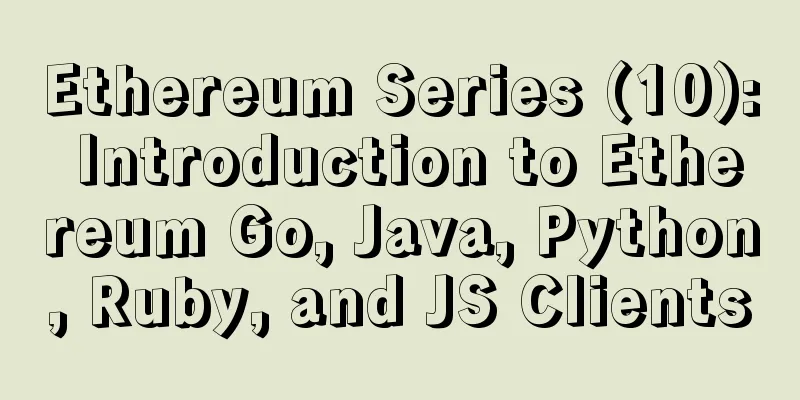Ethereum Series (10): Introduction to Ethereum Go, Java, Python, Ruby, and JS Clients

go-ethereumThe go-ethereum client is commonly referred to as geth, which is a command-line interface that executes a complete Ethereum node implemented in Go. By installing and running geth, you can participate in the Ethereum front-end real-time network and perform the following operations:
Link:
pyethappPyethapp is a Python-based client that implements the Ethereum cryptoeconomic state machine. The Python implementation aims to provide a code base that is easier to cut and extend. Pyethapp uses two core Ethereum components to implement the client:
Link:
ethereumjs-libAs stated in the yellow paper, ethereumjs-lib is a javascript library for core Ethereum functionality. It is a simple meta-module that provides the following modules. Most of the JS modules are tracked on ethereumjs.
Link:
Ethereum(J)Ethereum(J) is a pure Java implementation of the Ethereum protocol. It is provided as a library that can be embedded in any Java/Scala project and provides full support for the Ethereum protocol and ancillary services. Ethereum(J) was originally developed by Roman Mandeleil and is now funded by <ether.camp>. Ethereum(J) supports CPU mining. It is currently implemented in pure Java and can be used on private and test networks. You can even mine on the live Ethereum network, but it is not economically viable. Link:
ethereumHThis package provides tools written in Haskell that allow you to connect to the Ethereum blockchain. Link:
ParityParity claims to be the fastest and lightest client in the world. It is written in Rust, which enhances reliability, performance, and code clarity. Parity is developed by Ethcore. Ethcore was created by several members of the Ethereum Foundation.
Arch Linux packages are community maintained by Afri Schoedon and quininer.
Some people have reported success running Parity on a Raspberry Pi 2. ruby-ethereumruby-ethereum is an implementation of the Ethereum virtual machine, written in Ruby. Link:
Related:
References:For links to the list in the article, please refer to "Ethereum Homestead Documentation" page 41 1.2.4 go-ethereum In the next article we will introduce "Ethereum Series (11): Ethereum Account Management" Thanks to Azure and Bob from the Chaoxi team for participating in the translation and proofreading of "Ethereum Homestead Documentation". |
<<: Is there a secret behind Bitcoin mixing? Bitfury's research reveals the secrets of transactions
>>: Samsung SDS invests in blockchain company
Recommend
Top 10 Bitcoin Predictions for 2016
Charlie Woolnough, co-founder of Bitcoin business...
Don't believe me, verify it yourself
The author, jl2012, is a Bitcoin technology enthu...
The way you speak reflects your personality
The way you speak reflects your personality Do yo...
Whether you have good luck in studying can be seen from your face
To see whether a person is smart, just look at th...
Genesis Digital Assets and Canaan Technology Renew Order for 10,000 Mining Machines
On June 16, 2021, Canaan Technology renewed its o...
Rare palm lines for women with a rich destiny
There are verses describing beauties in The Book ...
Is it good for a woman to have a mole on her left ear?
In mole physiognomy, it is generally believed tha...
Do women with big feet have bad luck? Do women with big feet look rich or are they born to work hard?
In physiognomy, the fate of each person can actua...
I plan to leave with the flagship S9
Text | Huang Xuejiao Editor | Mandy Wang Mengdie ...
Crypto experts discuss miners' non-voting claims on Twitter
Bitcoin expert Steve Patterson appealed to the BC...
Let others do things that you can do first.
When doing something, some people's principle...
A man who is loyal to his wife
A man who is loyal to his wife 1. Big front teeth...
PoW may seem outdated, but innovation has not stopped
Kaspa, a new PoW project, has performed well rece...
A stubborn palm! Palmistry love line diagram analysis
How to read the love line diagram in palmistry? T...
Bitcoin and Trust from the Perspective of a French History Teacher
Hello everyone, I am French, and I am a member of...









